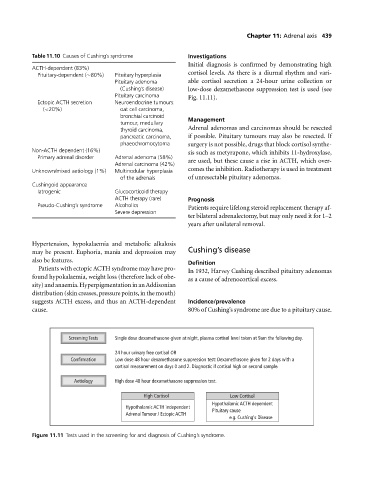Page 443 - Medicine and Surgery
P. 443
P1: FAW
BLUK007-11 BLUK007-Kendall May 25, 2005 8:5 Char Count= 0
Chapter 11: Adrenal axis 439
Table 11.10 Causes of Cushing’s syndrome Investigations
Initial diagnosis is confirmed by demonstrating high
ACTH-dependent (83%)
Pituitary-dependent (∼80%) Pituitary hyperplasia cortisol levels. As there is a diurnal rhythm and vari-
Pituitary adenoma able cortisol secretion a 24-hour urine collection or
(Cushing’s disease) low-dose dexamethasone suppression test is used (see
Pituitary carcinoma Fig. 11.11).
Ectopic ACTH secretion Neuroendocrine tumours:
(<20%) oat cell carcinoma,
bronchial carcinoid Management
tumour, medullary
thyroid carcinoma, Adrenal adenomas and carcinomas should be resected
pancreatic carcinoma, if possible. Pituitary tumours may also be resected. If
phaeochromocytoma surgery is not possible, drugs that block cortisol synthe-
Non-ACTH dependent (16%) sis such as metyrapone, which inhibits 11-hydroxylase,
Primary adrenal disorder Adrenal adenoma (58%) are used, but these cause a rise in ACTH, which over-
Adrenal carcinoma (42%)
Unknown/mixed aetiology (1%) Multinodular hyperplasia comes the inhibition. Radiotherapy is used in treatment
of the adrenals of unresectable pituitary adenomas.
Cushingoid appearance
Iatrogenic Glucocorticoid therapy
ACTH therapy (rare) Prognosis
Pseudo-Cushing’s syndrome Alcoholics Patients require lifelong steroid replacement therapy af-
Severe depression
terbilateral adrenalectomy, but may only need it for 1–2
years after unilateral removal.
Hypertension, hypokalaemia and metabolic alkalosis
may be present. Euphoria, mania and depression may Cushing’s disease
also be features. Definition
Patients with ectopic ACTH syndrome may have pro- In 1932, Harvey Cushing described pituitary adenomas
found hypokalaemia, weight loss (therefore lack of obe- as a cause of adrenocortical excess.
sity)andanaemia.HyperpigmentationinanAddisonian
distribution(skincreases,pressurepoints,inthemouth)
suggests ACTH excess, and thus an ACTH-dependent Incidence/prevalence
cause. 80% of Cushing’s syndrome are due to a pituitary cause.
Screening Tests Single dose dexamethasone given at night, plasma cortisol level taken at 9am the following day.
24 hour urinary free cortisol OR
Confirmation Low dose 48 hour dexamethasone suppression test: Dexamethasone given for 2 days with a
cortisol measurement on days 0 and 2. Diagnostic if cortisol high on second sample.
Aetiology High dose 48 hour dexamethasone suppression test.
High Cortisol Low Cortisol
Hypothalamic ACTH dependent
Hypothalamic ACTH independent Pituitary cause
Adrenal Tumour / Ectopic ACTH
e.g. Cushing‘s Disease
Figure 11.11 Tests used in the screening for and diagnosis of Cushing’s syndrome.

